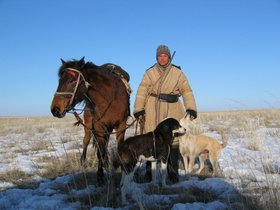Kazakh
|
|
Old_Kazakh_fellow_with_his_camel.jpg
The Kazakhs (also spelled Kazak, Qazaq, or Quazaq), (in Kazakh: Қазақ; in Russian: Казах; English term is the transliteration from Russian) are a Turkic people of the northern parts of Central Asia (largely Kazakhstan, but also found in parts of Russia and China). They have been famous in the past for the fierce love of freedom, skillful horse riding, hunting with semi-domesticated eagles, and currently (as of 2003), for the rapid economic growth of the independent state of Kazakhstan. Ethnically, they are a mix of early Turkic and Mongol tribes.
The word Kazakh was included in a Turkish-Arabian dictionary of the 13th century AD. The meaning of this word was given as "independent" or "free." The true meaning of the word is a matter of debate: some say it is related to "Ak Kaz", which means "white swan." Other theories exist as well.
Every Kazakh man is in one of three Zhüz (ЖYЗ), 'Junior zhuz, Middle Zhuz & Higher Zhuz. There are also tribes in every zhuz.
Kazakh also have three ancient groups: Сак (Sak), Гунн (Ghunn) and Скиф (Skif)
| Contents |
Culture
Persian, Russian and in smaller degree Arab cultures influenced the current Kazakh traditions. Modern Kazakhstan is the location of Sarmatians described in a segment of the PBS "Secrets of the Dead" series, "Warrior Amazon Women" (http://www.thirteen.org/pressroom/release.php?get=1278)
Language
The Kazakh language is a member of the Turkic language family, as are Uzbek, Kyrgyz, Tatar, Uighur, Turkish, Azeri, Turkmen, and many other living and historical languages spoken in Eastern Europe, Central Asia, Western China, and Siberia.
Kazakh is a member of the so-called Kipchak subgroup of the Turkic family, as for example is Qaraqalpaq. These languages are characterized, in distinction to other Turkic languages, by the presence of /s/ in place of reconstructed proto-Turkic */š/ and /š/ in place of */ç/; further, Kazakh has /j/ (alveodental affricate) where other Turkic languages have /y/ (glide).
Kazakh, like most Turkic languages lacks phonemic vowel length, and as such there is no distinction between long and short vowels.
Before 1917, Kazakh was written in the Arabic alphabet. Between 1917 and 1926 it was written with a modified version of the Latin alphabet similar to that used for Republican Turkish. Since 1926 it has been written in a variant of the Cyrillic script with extra characters to represent phonemes not present in Russian.
Kazakh is one of the principal languages spoken in Kazakhstan, along with Russian. It is also spoken in the Ili region of the Xinjiang Uighur Autonomous Region in the People's Republic of China.
Kazakh tribalism
Kazakh_woman_in_her_front_yard_in_winter.jpg
Traditionally, Kazakhs tracked their tribal roots. Every Kazakh was supposed to know his/her tribe and all grandparents of at least 7 generations. Kazakhs were not allowed to marry if they had a common predecessor within 7 generations. When a man and a woman marry, their children usually become members of the husband's tribe. Inter-tribe marriages were encouraged.
In modern Kazakhstan, tribalism is officially prohibited, practically almost negligible, and definitely fading away in business and government life. However, it still exists and sometimes plays a subtle role here and there. It is a very important component of Kazakh culture. It's very common for Kazakhs to ask which tribe they belong to when they meet each other. There is no hostility between tribes, and Kazakhs, regardless of their tribal origin, consider themselves one nation.
Tribalism played a much greater role during Soviet times, especially when the head of Kazakhstan's Communist Party was D.A. Kunaev. Unfortunately, tribal origin was a hidden factor in work and social life.
Kazakhs in China
The Kazakhs also form one of the 56 ethnic groups officially recognized by the People's Republic of China.
There is one Kazakh autonomous prefecture in the People's Republic of China: the Illi Kazakh Autonomous Prefecture, in the Xinjiang Uighur Autonomous Region.
Kazakhs in Russia
Pockets of Kazakhs can be found in the Oblasts bordering Kazakhstan.
Related articles
External links
- Welcome to Kazakstan (http://members.tripod.com/~kz2000/main.html)
|
Chinese ethnic groups (classification by PRC government) |
|
Achang - Bai - Blang - Bonan - Buyei - Chosen - Dai - Daur - De'ang - Derung - Dong - Dongxiang - Ewenki - Gaoshan - Gelao - Gin - Han - Hani - Hezhen - Hui - Jingpo - Jino - Kazak - Kirgiz - Lahu - Lhoba - Li - Lisu - Man - Maonan - Miao - Monba - Mongol - Mulao - Naxi - Nu - Oroqen - Pumi - Qiang - Russ - Salar - She - Sui - Tajik - Tatar - Tu - Tujia - Uygur - Uzbek - Va - Xibe - Yao - Yi - Yugur - Zang - Zhuang |
ko:카작족 ka:ყაზახები kk:Қазақ ja:カザフ pl:Kazachowie sv:Kazaker zh:哈萨克族

